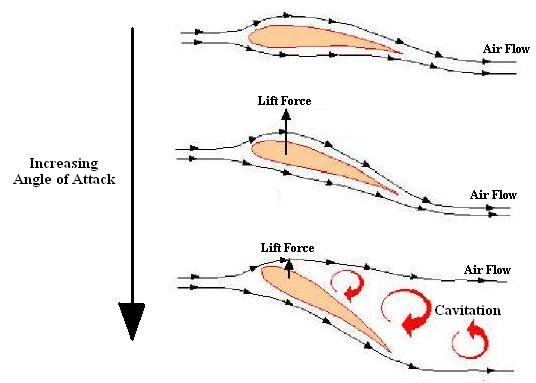I suspect the huge difference & I'm sure the areo guys will pan me for this, is that in AH, many planes can be held in the buffet and turn quite well while in this situation. Realistically, I'd Imagen that with the air separating at the wings and all the turbulence above the wing (causing the buffet) would cause the plane to just drop and loose even more e, preventing one from maintaining a turn in the buffet for longer than a split second. For example, in a 109 or a spit, I can hold the plane in the buffet for as long as necessary, even climb while its buffeting....

First, this picture is horribly wrong because it deleted the single most important part of the airflow - the big circular airflow on the trailing edge of the wing. Instead, (many) textbooks show this nice flow going past the trailing edge, leaving it undisturbed as if the wing never passed through the air. It is the circular flow that is responsible for the generation of lift. What happens in a stall is that the one semi-ordered rotational flow breaks into small vortices as in the 3rd sketch. This destroys the "suction" of air from over the wing and stops the large-scale circular flow pattern around the whole wing (the air above flow faster than the air below bla bla Bernuli).
Here, see what happens behind the wing (cuts part of the circular flow behind):
http://youtu.be/Vjk9Ux2COx0The advantage of this movie is that it uses drifting particles to visualize the flow instead of smoke. Smoke trails tend to stick to the laminar flow and do not highlight the rotational flow behind the wing. Some of the smoke is sheared and enter the vortex, but then it is well mixed and look like uniform faint haze, so it is hard to see - this is why it is named "separation" of the air flow. The air does not really leave the wing (no vacuum over it which would actually increase lift..) it is the smoke lines used in wind tunnels that give this impression.
The transition in many cases is not as sudden as you might think. The large circular patters on the trailing edge starts to wobble and small vortices break off of it before it is completely destroyed. This instability is part of the buffeting. You can see it in this movie (this time with smoke, notice the difference in what you see vs. the other movie):
http://youtu.be/6UlsArvbTeoThe wobbles of the flow lines behind the wing is the onset of stall, but the wing still produces lift at this stage.
Another effect is that parts of the plane reach this stall before others. A twist along the length of the wing will cause the root to stall before the tips. In a real plane there may be turbulence created around parts that are not supposed to create lift at all, like fuselage/canopy sections that are not ideally aligned with the airflow at high AOA.